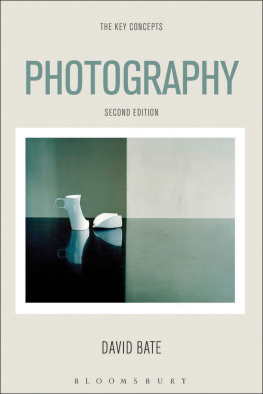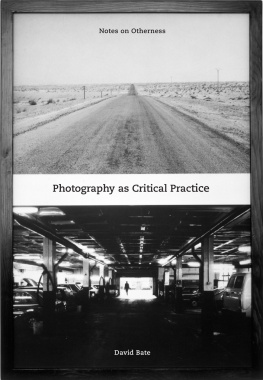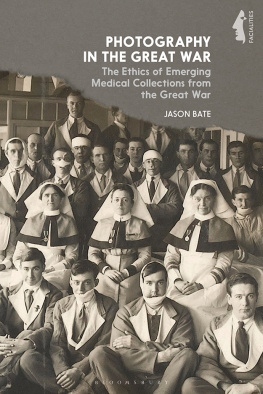Bate - Photography: The Key Concepts
Here you can read online Bate - Photography: The Key Concepts full text of the book (entire story) in english for free. Download pdf and epub, get meaning, cover and reviews about this ebook. year: 2016, publisher: Bloomsbury Publishing Plc, genre: Romance novel. Description of the work, (preface) as well as reviews are available. Best literature library LitArk.com created for fans of good reading and offers a wide selection of genres:
Romance novel
Science fiction
Adventure
Detective
Science
History
Home and family
Prose
Art
Politics
Computer
Non-fiction
Religion
Business
Children
Humor
Choose a favorite category and find really read worthwhile books. Enjoy immersion in the world of imagination, feel the emotions of the characters or learn something new for yourself, make an fascinating discovery.
- Book:Photography: The Key Concepts
- Author:
- Publisher:Bloomsbury Publishing Plc
- Genre:
- Year:2016
- Rating:4 / 5
- Favourites:Add to favourites
- Your mark:
- 80
- 1
- 2
- 3
- 4
- 5
Photography: The Key Concepts: summary, description and annotation
We offer to read an annotation, description, summary or preface (depends on what the author of the book "Photography: The Key Concepts" wrote himself). If you haven't found the necessary information about the book — write in the comments, we will try to find it.
Bate: author's other books
Who wrote Photography: The Key Concepts? Find out the surname, the name of the author of the book and a list of all author's works by series.
Photography: The Key Concepts — read online for free the complete book (whole text) full work
Below is the text of the book, divided by pages. System saving the place of the last page read, allows you to conveniently read the book "Photography: The Key Concepts" online for free, without having to search again every time where you left off. Put a bookmark, and you can go to the page where you finished reading at any time.
Font size:
Interval:
Bookmark:

Photography
THE KEY CONCEPTS SERIES
ISSN 1747-6550
The series aims to cover the core disciplines and the key cross-disciplinary ideas across the Humanities and Social Sciences. Each book isolates the key concepts to map out the theoretical terrain across a specific subject or idea.
Designed specifically for student readers, each book in the series includes boxed case material, summary chapter bullet points, annotated guides to further reading, and questions for essays and class discussion.
Design: The Key Concepts
Mark Westgarth and Eleanor Quince
Fashion: The Key Concepts
Jennifer Craik
Film: The Key Concepts
Nitzan Ben-Shaul
Food: The Key Concepts
Warren Belasco
Globalization: The Key Concepts (1st Edition)
Thomas Hylland Eriksen
Globalization: The Key Concepts (2nd Edition)
Thomas Hylland Eriksen
Technoculture: The Key Concepts
Debra Benita Shaw
The Body: The Key Concepts
Lisa Blackman
New Media: The Key Concepts
Nicholas Gane and David Beer
Photography: The Key Concepts (1st Edition)
David Bate
Photography: The
Key Concepts
Second Edition
DAVID BATE
Bloomsbury Academic
An imprint of Bloomsbury Publishing Plc

Contents
Figures
1 Photography Theory
2 Snapshots and Institutions
3 Documentary and Storytelling
4 Seeing Portraits
5 The Composition of Landscapes
6 The Object of Still-Life
7 Photography and Art
8 Global Photography
9 The Scopic Drive
10 History and Photography
Colour Plates
T hanks to Paula Gortzar for her picture research work and to Davida Forbes for her care, efficiency, and patience as editor at Bloomsbury.
T he first edition of this book was published in 2009. It has been translated into several different languages and adopted as a standard textbook: a reference for the study of photography at many different levels. So why make a new edition of the book? There are three main reasons. First, most obviously new is the greater number of visual images in this edition, the advantage of which is surely as obvious: as references for students of photography. The photographs included do not form any kind of canon, but are indicative of different ways of treating the topics and themes referred to in the text.
Secondly, the practical requirements of the series that the first edition was published in meant an inevitable squeezing of the topic. This new edition has two additional chapters, alongside minor revisions to the existing ones, where improvements could be made. One of the new chapters is on Snapshots and Institutions, including the public/private domains that are in transition, the other is on The Scopic Drive and the more general situation of looking and photography in our visual culture. These essays were written specifically for this edition and have in mind some of the issues indicated below.
The third reason is probably far more complex. In the interval between the first edition of this book, photography has undergone a vivid set of changes. Some may even say it is no longer photography, and that the technical revolution of computing and the massive range of new cultural uses of the Internet have changed it beyond all recognition. Some would thus say we should call our age post-photography or even be talking about post-digital photography. Yet the word photography and the range of practices it gives rise to seem curiously resistant to such nominal changes. Despite the many and often wild claims about the demise of indexical reference and endless philosophical critique of the ontological status of the photographic image, photography is nevertheless still here. So although many technological changes have provoked debates about photographic truth and the relation to what we still call reality, it has become ever more clear that the way people conceive of these new issues is often part of the problem, rather than any solution to the questions that are raised.
New media critics have been keen to throw out the photographic image with darkroom chemicals, which are substituted with data screen files, algorithms and bytes. Paper prints are replaced with data screen images, yet the transition to digital images has turned out to be not so much a revolution as a sliding evolution. As photography has entered into the more comfortable realms of art, the brave new world of digital photography turns out to be a remarkable reinvention of the wheel. The radical changes, it seems to me, are more in the modes and relations of distribution and dissemination of images than in the specific forms of photographic images themselves. While it is true that fantasy is more prevalent in the construction of images, it is the new relations between the Internet and existing social institutionswhose legal, ethical, judicial, and political status is still being worked throughthat the real transformations are beginning to occur.
In the democratic use of the Internet, different types of images that were formerly regarded as insignificant or minor practices (e.g., in war photography the private trophy pictures made by soldiers are more public, and the vast domains of amateur and professional photographic pornographythese have all existed since the early practical days of photography) have found a new social visibility, not yet repressed or restricted to personal use as they were in earlier periods. Out in the open on the Internet, these practices skew the old ways we see and value many public and private institutions, which shakes up the established relations of appearance between them and us. These changes are profound, they actually affect our whole perception of society. The once more clearly demarcated institutional fields of photographic discourse, like news, advertising, entertainment, and politics all appear, sometimes indiscernibly, mixed and juggled alongside each other on webpages in different, sometimes bizarre, and perhaps even in exciting new ways. Is the medical advice given on a webpage to be distinguished from the pharmaceutical advertisements that accompany it (advertorials)? How do we distinguish product advice from independent fact? Who is speaking there, it is often worthwhile to ask?
But what of the photographic image itself? Certainly in art, advertising, fashion, and news photography there are new and innovative practices, but how far these are all new because of their digital foundation, rather than because of what they enable in the wider appearance of human imagination remains to be seen. I say this, not because the old film-based negative seems now to have a certainty that the data file does not, nor because, data screen images are less permanent than paper prints, but because beneath the glossy appearance of all these new shiny images, the same critical questions about the photographic image still apply. Indeed, we should also note, for example, that after all, whether paper or LCD, these are still all just variant types of screen, which any visual image requires for its formation. Computerized and decentralized, the photographic image nevertheless retains a kind of social charm. The still photograph features as yet a highly central form across the nexus of social media and interactive life.
This new edition has given an opportunity to add material relating to these new issues, but in a way that does not simply dismiss the important debates and questions about practices, nor exchange them for some new myth of creativity as data art. The contemporary challenge is to find a way to talk about the new incarnations of photographic forms that often still exist inside the old ones, and which have not gone away. We should have learned by now that discontinuities and continuities are in fact typical of the whole history of photographic, if not all human, culture, and indeed all technology. About 330 bc Aristotle proposed in his The Art of Rhetoric three genres of speech. Today, perhaps, it seems we have many more genres of speech, alongside the domain of everyday chatter and talk. Perhaps we do now have to include photography and photographic images here, as fully entered into this domain too, as visual talk. These newold forms demand critical understanding and analysis of their operations. It is a goal that remains within the ambition of this book. That is, to outline genres of photographic speech that are fixed and mutable. The experience of this contradiction is felt nowhere more so than when browsing the internet. Finally, I must add that I hope all these new changes do not detract from the simple usefulness of the first edition.
Font size:
Interval:
Bookmark:
Similar books «Photography: The Key Concepts»
Look at similar books to Photography: The Key Concepts. We have selected literature similar in name and meaning in the hope of providing readers with more options to find new, interesting, not yet read works.
Discussion, reviews of the book Photography: The Key Concepts and just readers' own opinions. Leave your comments, write what you think about the work, its meaning or the main characters. Specify what exactly you liked and what you didn't like, and why you think so.












